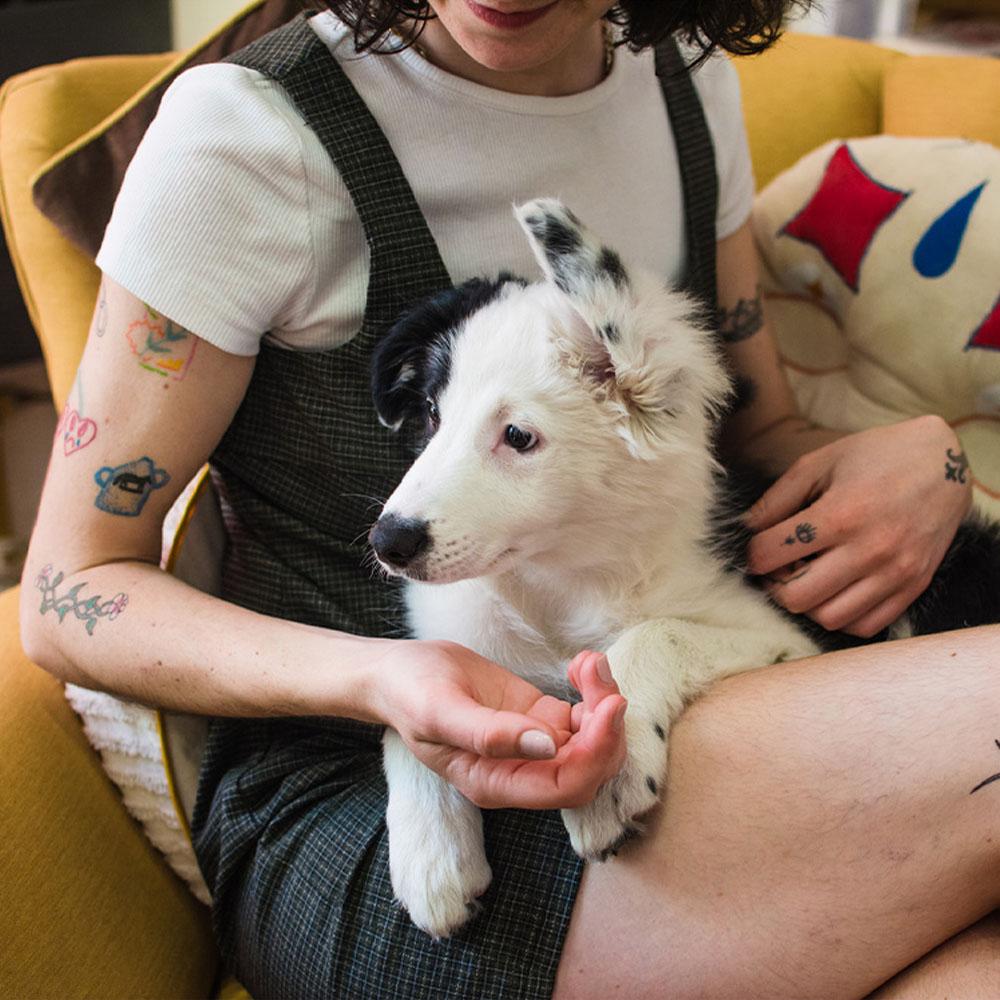How Much Does A Dog Cost? Average Monthly Costs
Thinking of adopting a dog? Learn more about the average monthly costs of dog parenthood.
Thinking of adopting a dog? Learn more about the average monthly costs of dog parenthood.
by Savannah Admire, | August 8, 2023

Ana Luz Crespi / Stocksy
Adopting a dog is a significant financial investment, not only in one-time upfront costs but also over the course of your pup’s life. Of course, most pet parents would say that every penny is worth it — and it’s easy to forgive and forget those costs when looking into your dog’s loving eyes. Still, it’s important to learn all about the cost of having a dog to help you decide whether you’re ready for the commitment.
The costs of having a dog start right away, including the cost of getting a dog. Breeders charge a significant amount of money, often between $1,000 and $5,000, for a purebred puppy. Adoption fees for dogs vary depending on the shelter or rescue but cost much less, usually around several hundred dollars, and allow you to provide a home to an animal in need and make room for the shelter to help more animals.
After adoption, multiple costs arise during the first year of dog parenthood, including initial veterinarian visits, spaying or neutering, microchipping and licensing, and, of course, buying all the supplies your dog will need. Based on the following cost breakdowns, your first year may cost anywhere from $420 to $3,270. We suggest setting a budget at a minimum of $2,000 for your first year as a dog parent.
It’s important to understand all the responsibilities and costs of adopting a dog, so here’s a breakdown of the price ranges for each one-time adoption item below.
Adoption fee – $100 to $800
Vaccinations – $350 to $450 for initial exam and vaccinations, $115 to $230 annually
Spay/neuter surgery – $200 to $700
Licensing – $20 to $100 (may include microchip)
Microchip – $30 to $100, $50 on average
Training – $30 to $1,250
Initial supplies – $100 to $2,000:
When it comes to initial vaccinations, as well as spay and neuter surgery, you can look for low-cost programs and clinics in your area. Some rescues also cover the cost of spaying or neutering and even up-to-date vaccines as part of their adoption fee, eliminating the cost of getting a dog spayed from your budget.
Pet spending has only increased in the last few years, with pet parents spending over $130 billion in 2022. That’s because one of the responsibilities of having a dog is purchasing a lot of supplies to keep them safe, healthy, and entertained in their new home.
Depending on how big you want to go with toys, treats, and essentials, expect to spend several hundred dollars outfitting your home for your new family member. For a small dog, figure on $100 for initial supplies; for a medium dog, $200; and for a giant breed dog, $300 and up.
Supplies vary in cost depending on the brand, material, and quality, so do your research and choose the best options for your new pet and your budget.
Other basic pet supplies you might not think about include:
Booties
Jackets and sweaters (depending on your climate and your dog’s coat type)
Dog poop bags
Camera monitor
Orthopedic bed
Ramp or stairs (depending on the size and age of your dog)
Potty pads
Stain and odor remover
Once you’ve bought all the supplies and taken your dog for their first vaccinations at the vet, there are still ongoing costs that add up over the course of a year. Vet care, food, and services like boarding, grooming, and dog walking are generally the three largest expenses when it comes to dog parenthood.
Dogs also require annual visits to the vet for check-ups and any required vaccinations, as well as flea and heartworm prevention to keep them healthy. While pet insurance is optional, it’s a great way to prepare for unexpected medical expenses.
Long-haired dogs also require regular grooming, and even short-haired dogs need the occasional bath and nail trim. Of course, all dogs need high-quality food designed to meet their nutritional needs, which is a major expense of dog parenthood.
The average cost of a dog per year can be anywhere from $1,270 to $2,803, so it‘s a good idea to have a healthy budget for your dog’s needs. And keeping up with their training is important too, so expect to spend about $250 per year if you sign up for basic training classes. We suggest budgeting a minimum of $2,500 annually, including the following items:
Dog food – $120 to $900
Toys and treats – $30 to $200
Medical expenses – $750 to $1,750
Pet insurance – $280 to $1,030
Additional supplies – $30 to $250
Training – $30 to $250
Puppies are more expensive because they typically need a series of vet visits for vaccinations, routine check-ups, more toys, larger collars as they grow, and training. They also tend to be the ones that chew up your couch cushions.
Senior dogs, however, may have more health issues, which could increase your annual costs, especially if you need to invest in multiple medications, special foods, and ramps or other mobility aids. Older dogs are more prone to diseases like heart, kidney, and liver diseases, arthritis, and cancer, so the cost per year for medications and veterinary treatment goes up. The exact age at which a dog is considered “senior“ depends a lot on the size of the breed, as larger breeds (and purebreds) typically develop health problems much sooner than smaller and mixed-breed dogs.
While you can budget for your dog’s anticipated monthly needs, there will always be expenses you can’t plan for, such as illness and injury. Emergency veterinary care can set you back several thousand dollars in a single visit, and chronic illnesses can balloon your budget. Here are a few unexpected expenses to consider:
Emergency vet care
Long-term illness
Extensive behavior training
Boarding or pet sitting if you travel
Destruction of valuable items (shoes, furniture, landscaping)
If you live in a rental, you should also factor in the cost of a pet deposit, usually around $200 to $500, in your overall cost of raising a dog.
Creating an emergency fund for your dog’s needs can help you avoid financial stress when an unexpected expense comes up. Set aside a little money each month for your pet, factoring this amount into your monthly budget. You can choose a specific amount to save or just budget the average cost of having a dog per month. You can even create a separate savings account to easily draw on this money should you have to rush your dog to the emergency vet or invest in more extensive training classes.
Investing in pet insurance can help you prepare for unexpected expenses and keep your budget from taking a hit if your dog becomes injured or ill. While you can budget for standard pet parent costs, like food, annual vet care, and flea and tick preventative, there’s really no way to budget for accidents or serious health conditions, which can happen at any time. Fortunately, the younger your dog is when you purchase pet insurance, the more affordable and better the coverage. Just make sure to do your research and get several quotes because the cost of monthly premiums can vary widely.
While cats are lower-maintenance than dogs and tend to be less expensive because of their smaller size, cats do have a longer lifespan —about 15 years on average, and many live to 20 — which means that you’re looking at a longer-term commitment when comparing the cost of a cat compared to a dog.
Just like with a dog, the initial expenses of adopting a cat, including adoption fees, vaccinations, and supplies, are significant, usually around $350 to $950. However, the cost of having a dog still tends to be higher, with the average dog parent spending $3,350 annually in 2021, compared to $2,377 for cat parents. It’s important to understand the financial commitment involved in adopting a pet and to ask yourself, “Can I afford a dog?“ before taking that big step.
The average monthly cost of taking care of a dog ranges from $40 to $290.
Most pet parents spend around $1,000 a year on their dog, but the total varies depending on the dog’s size, age, health, and the pet parent’s purchasing choices.
The three biggest expenses of dog parenthood are medical care, food, and services like grooming and boarding.
The basic supplies you need for a dog will usually run around $500 to $1,000.
All dogs need regular nutritious meals and annual veterinary check-ups. Long-haired dogs need regular grooming, and short-haired dogs need regular baths and nail trims.
Pet insurance can help you cover unexpected medical expenses, like illness or injury. You may also want to invest in pet-sitting services if you travel regularly.
Prepare for emergency vet care for illness or injury, as it can be a major expense, as well as boarding and grooming.
While puppies can be very costly initially, older dogs also have higher costs because of more frequent vet visits and medications.
Marketwatch: Cost of Owning a Dog
How Much it Costs to Own a Pet
Real Cost of Owning a Dog or Cat
How Much Does Your Pet Cost You Per Year

Savannah Admire is a writer, editor, and pet parent to two dogs and a cat. When she’s not writing, you can find her reading, playing Animal Crossing, or being an obnoxious nerd about her favorite movies and TV shows. She lives in Maryland, where she constantly debates whether or not to get a third dog.